| Article ID | Journal | Published Year | Pages | File Type |
|---|---|---|---|---|
| 1242862 | Talanta | 2010 | 4 Pages |
Effect of phase stability degradation of bismuth on sensor characteristics of nano-bismuth fixed electrode has been investigated using square-wave anodic stripping voltammetry technique, scanning electron microscopy (SEM) and X-ray diffraction (XRD) spectroscopy. From the analyses of square-wave anodic stripping voltammograms (SWASV) repetitively measured on the nano-bismuth fixed electrode, it was found that the oxidation peak currents dropped by 81%, 68% and 59% for zinc, cadmium and lead, respectively, after the 100th measurement (about 400 min of operation time). The sphere bismuth nanoparticles gradually changed to the agglomerates with petal shape as the operation time increased. From the analyses of SEM images and XRD patterns, it is confirmed that the oxidation of Bi into BiOCl/Bi2O2CO3 and the agglomeration of bismuth nanoparticles caused by the phase change decrease a reproducibility of the stripping voltammetric response. Moreover, most of the bismuth becomes BiOCl at pH 3.0 and bismuth hydroxide, Bi(OH)3 at pH 7.0, which results in a significant decrease in sensitivity of the nano-bismuth fixed electrode.
